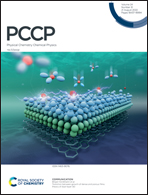Single-gas and mixed-gas permeation of N2/CH4 in thermally-rearranged TR-PBO membranes and their 6FDA-bisAPAF polyimide precursor studied by molecular dynamics simulations†
Abstract
High-performance polymers with polybenzoxazole (PBO) structures, formed via thermal rearrangement (TR) of aromatic polyimide precursors, have been developed for gas separation applications. The present work compares the transport of N2 and CH4 in a 6FDA-bisAPAF polyimide precursor and in its TR-PBO derivative using molecular dynamics (MD) simulations. The modelling closely mimicked the experimental approach by transforming a 6FDA-bisAPAF atomistic model into its corresponding TR-PBO structure via a specific algorithm. The densities and void spaces of both precursor and TR polymers were found to compare well to experimental data. An iterative technique was used to obtain the single-gas sorption isotherms of N2 and CH4 at 338.5 K in both polymers over a range of feed pressures up to and exceeding 65 bar. CH4 was systematically found to be more soluble than N2. Solubilities in both matrices were quite similar with those in TR-PBO being slightly higher due to its larger fraction of significant volume. Volume dilation analyses confirmed a higher resistance to plasticization for TR-PBO. Extended single-gas N2 and CH4 simulations and 2 : 1 binary CH4/N2 mixed-gas simulations were then conducted in both matrices at 338.5 K and at a pressure of ∼65 bar corresponding to natural gas processing conditions. Mixed-gas sorption was modelled using a modification of the aforementioned iterative method, which fixed the pressure and iterated to convergence the number of molecules of each type of penetrant. The gas diffusion coefficients were estimated using the Trajectory-Extending Kinetic Monte Carlo (TEKMC) procedure. As found experimentally, significantly higher diffusivities and permeabilities were observed in the TR polymer, which led to a slightly lower ideal N2/CH4 permselectivity for TR-PBO (∼2.6) when compared to its 6FDA-bisAPAF precursor (∼3.8). However, both models showed a reduced N2/CH4 separation efficiency under 2 : 1 binary CH4/N2 mixed-gas conditions bordering on the loss of selectivity. For 6FDA-bisAPAF, both permeabilities decreased in the mixed-gas case, but more for N2 than for CH4. For TR-PBO, the permeability of the faster N2 decreased while the permeability of the slower CH4 increased under mixed-gas conditions. This confirms that single-gas simulations are not sufficient for the prediction of the actual mixed-gas permselectivity behaviour in such polymers.



 Please wait while we load your content...
Please wait while we load your content...